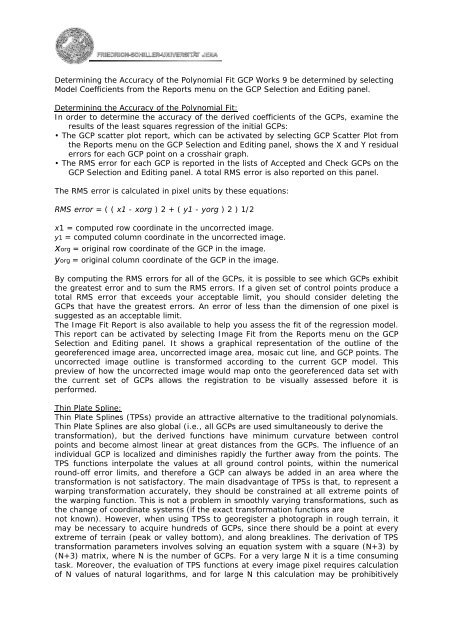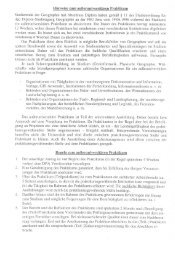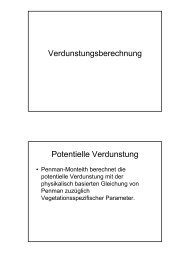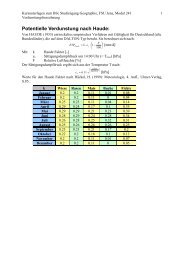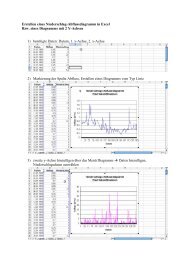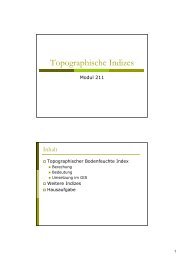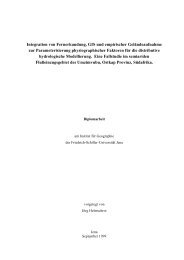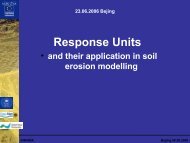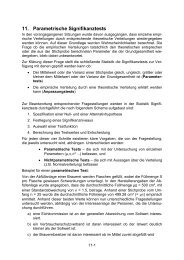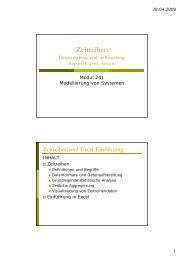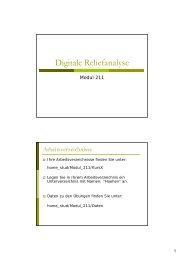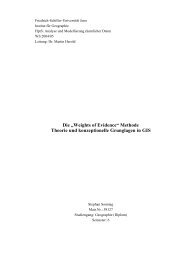Fernerkundung I (Digitale Bildverarbeitung) - Friedrich-Schiller ...
Fernerkundung I (Digitale Bildverarbeitung) - Friedrich-Schiller ...
Fernerkundung I (Digitale Bildverarbeitung) - Friedrich-Schiller ...
Create successful ePaper yourself
Turn your PDF publications into a flip-book with our unique Google optimized e-Paper software.
Determining the Accuracy of the Polynomial Fit GCP Works 9 be determined by selecting<br />
Model Coefficients from the Reports menu on the GCP Selection and Editing panel.<br />
Determining the Accuracy of the Polynomial Fit:<br />
In order to determine the accuracy of the derived coefficients of the GCPs, examine the<br />
results of the least squares regression of the initial GCPs:<br />
• The GCP scatter plot report, which can be activated by selecting GCP Scatter Plot from<br />
the Reports menu on the GCP Selection and Editing panel, shows the X and Y residual<br />
errors for each GCP point on a crosshair graph.<br />
• The RMS error for each GCP is reported in the lists of Accepted and Check GCPs on the<br />
GCP Selection and Editing panel. A total RMS error is also reported on this panel.<br />
The RMS error is calculated in pixel units by these equations:<br />
RMS error = ( ( x1 - xorg ) 2 + ( y1 - yorg ) 2 ) 1/2<br />
x1 = computed row coordinate in the uncorrected image.<br />
y1 = computed column coordinate in the uncorrected image.<br />
xorg = original row coordinate of the GCP in the image.<br />
yorg = original column coordinate of the GCP in the image.<br />
By computing the RMS errors for all of the GCPs, it is possible to see which GCPs exhibit<br />
the greatest error and to sum the RMS errors. If a given set of control points produce a<br />
total RMS error that exceeds your acceptable limit, you should consider deleting the<br />
GCPs that have the greatest errors. An error of less than the dimension of one pixel is<br />
suggested as an acceptable limit.<br />
The Image Fit Report is also available to help you assess the fit of the regression model.<br />
This report can be activated by selecting Image Fit from the Reports menu on the GCP<br />
Selection and Editing panel. It shows a graphical representation of the outline of the<br />
georeferenced image area, uncorrected image area, mosaic cut line, and GCP points. The<br />
uncorrected image outline is transformed according to the current GCP model. This<br />
preview of how the uncorrected image would map onto the georeferenced data set with<br />
the current set of GCPs allows the registration to be visually assessed before it is<br />
performed.<br />
Thin Plate Spline:<br />
Thin Plate Splines (TPSs) provide an attractive alternative to the traditional polynomials.<br />
Thin Plate Splines are also global (i.e., all GCPs are used simultaneously to derive the<br />
transformation), but the derived functions have minimum curvature between control<br />
points and become almost linear at great distances from the GCPs. The influence of an<br />
individual GCP is localized and diminishes rapidly the further away from the points. The<br />
TPS functions interpolate the values at all ground control points, within the numerical<br />
round-off error limits, and therefore a GCP can always be added in an area where the<br />
transformation is not satisfactory. The main disadvantage of TPSs is that, to represent a<br />
warping transformation accurately, they should be constrained at all extreme points of<br />
the warping function. This is not a problem in smoothly varying transformations, such as<br />
the change of coordinate systems (if the exact transformation functions are<br />
not known). However, when using TPSs to georegister a photograph in rough terrain, it<br />
may be necessary to acquire hundreds of GCPs, since there should be a point at every<br />
extreme of terrain (peak or valley bottom), and along breaklines. The derivation of TPS<br />
transformation parameters involves solving an equation system with a square (N+3) by<br />
(N+3) matrix, where N is the number of GCPs. For a very large N it is a time consuming<br />
task. Moreover, the evaluation of TPS functions at every image pixel requires calculation<br />
of N values of natural logarithms, and for large N this calculation may be prohibitively


